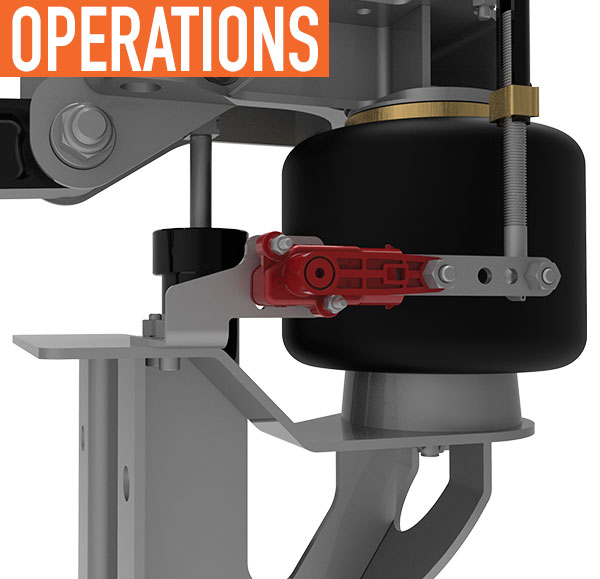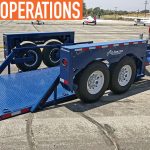An aggregate-laden dump truck makes the transition from on-road to off-road, transporting cargo to a remote jobsite. Under load, the cab’s heavy-duty springs perform as designed on the uneven terrain, providing a relatively smooth ride and manageable handling during moderate speed. But the ride after dropping the load is a different story.
“After transitioning from on- to off-highway conditions, cabs can be structurally damaged, vehicles can become harder to handle, and drivers can be forced to decrease speed to avoid losing control,” Bill Ott, vice president of engineering for Link Mfg., LTD, says. “Even at reduced speeds, operators may be exposed to dynamic forces that, according to ISO 2631-1:1997 standards, can cause internal injury over time.”
TAKE A SEAT
High-tech seating is adopted by OEMs, fleets, and owner-operators as a means of reducing the effects of energetic cab movement on drivers. But seating solutions only stabilize the driver. They don’t mitigate the forceful movement of the cab, steering wheel, gear shifter, and accelerator and brake pedals that surround the driver.
Seating solutions simply address one facet of a multifaceted problem. The potential for vehicle control issues and damage may actually be greater because the driver receives kinesthetic feedback from the seat that contradicts the actual forces imposed on the cab and its contents.
Ott says only one solution begins to address the problems caused by dynamic cab movement, and it must focus on dampening mechanical forces that affect the whole cab as a unit.
“A cab is basically just a mass on springs,” Ott says. “And a vehicle’s primary factory suspension is designed to deal effectively with the dynamic range of road conditions. So for almost 40 years, Link has focused its attention on the way in which a cab rides on its frame rails.”

Founded in 1980 by Bill Nibblink, an industrious and practical-thinking truck driver who made it his business to invent a more humane cab environment, the Link Cabmate® Cab Air Suspension System changed the way an entire industry views cab comfort. Today, Link supplies more OEM cab suspensions than anyone else. In May of 2019, the two millionth Cabmate rolled off the company’s Sioux Center, Iowa, assembly line.
“In 2014, Link’s engineering team began work on the next generation of Cabmate, this time a semi-active cab suspension,” Ott says. “We organized a kind of skunkworks-esque project group to focus on and invest time and resources in addressing this complex technical challenge.”
ROI
Link engineers explored the problem of designing a semi-active cab suspension from the ground up. A new and more advanced breed of electronic control unit (ECU) became available, and the group realized that it could leverage these improved units in its developmental process.
Writing proprietary algorithms, the team took advantage of the more powerful ECU processing capabilities as well as recently developed sensing mechanisms and shock absorbers to design an entirely new breed of cab suspension system.
Dubbed Road Optimized Innovations (ROI), the new technology enabled a suspension system to respond in real time to real-world conditions and driving events. The ROI Cabmate Semi-Active Cab Suspension was born.
The system employs multiple sensors and constantly assesses environmental circumstances while responding simultaneously. An accelerometer monitors the motion of the cab, while a position sensor measures the position and velocity of the cab relative to the frame.
Operating on Link’s software, the ECU interprets the information from the accelerometers and position sensors and instructs the suspension components to respond immediately and in concert. The advanced shock absorbers stiffen or slack on command, and air springs are filled or exhausted concurrently.
“The signals and the resulting dampening adjustments occur hundreds of times per second,” Ott says. “The result is a dynamic dampening state that is optimized for each instant.”
THIS IS ONLY A TEST
Link is certified to IATF 16949 standards (previously TS16949), and the company assembled a world-class testing lab that quantified the new suspension’s performance. When the ROI Cabmate was ready for its initial field testing, Link purchased a Peterbilt 579, featuring Link’s original Cabmate Cab Air Suspension System as standard equipment. The research vehicle enabled Link engineers to experience the ride quality with and without the new ROI Cabmate engaged.
Over the decades, Link engineers spent countless hours with OEMs, helping them measure cab suspension performance on closed tracks. Common test protocols include attaching accelerometers on the frame rails and the cab seat and then adjusting the suspension to perform according to the OEMs preferred “ride number.”
As a matter of practice, the industry calculates a ride number using ISO 2631-1:1997 standards. These are in part based on NASA experiments designed to measure the physical effects of human exposure to mechanical shock and vibration.

FEATURED IMAGE: The system uses a position sensor that measures the position and velocity of the cab relative to the frame.
ABOVE: The ROI Cabmate’s advanced shock absorbers stiffen or slack on command, and air springs are filled or exhausted concurrently.
Not only are ride numbers generally accepted within the industry, they are a way to quantify the difference in suspension characteristics. They are also often used to calculate the number of hours a driver can be exposed to the dynamic forces correlated to that ride number before potentially sustaining injury. In the past, suspensions were tuned to achieve a desired ride number, and the tuning parameters remained fixed.
Ott explains that with the ROI Cabmate, suspension systems no longer rely on a predetermined configuration. Instead, ROI Cabmate assesses actual conditions and immediately, accurately, and precisely responds, delivering the right suspension behaviors in any situation. “It’s quite simply a game changer,” Ott says.
Now for the next test…
MILLION-MILE CHALLENGE
Link set its sights gathering data from operators in the field and on logging a minimum of a million miles of performance statistics and feedback. Link tapped relationships with multiple fleets: C.R. England, Ploger Transportation, Valley Transportation in the US, and Transportes Consolidados in Latin America.
Participating drivers were enthusiastic about the improvement in ride and handling of ROI Cabmate-equipped vehicles. They also liked the electronic height control feature and confirmed a far better overall driving experience regardless of surface and atmospheric factors, such as wind sheer.
The fleets recognized multiple advantages associated with the Cabmate. They appreciated that the ROI Cabmate protected the whole cab and recognized that reduced stress on the equipment and drivers meant less maintenance, better handling, and injury reduction. All saw the potential associated with improved cab environment and driver retention.

The Cabmate Semi-Active Cab Suspension System also features electronic height control.
“We are always interested in learning about new technologies that can improve driver comfort, increase job satisfaction, promote safety, and reduce maintenance costs,” Gary Van Ekelenburg, director of equipment for C.R. England, says. His fleet was familiar with the traditional Cabmate suspension, “so field-testing Link’s new ROI Cabmate was a logical business decision and gave our drivers and our company a chance to experience the future of HD cab suspensions.”
THE ROAD AHEAD
Link’s ROI technology has the ability to not only revolutionize cab suspensions, but vehicle suspensions as a whole. Smarter suspensions are more responsive and more effectively provide optimal ride and handling for any given environmental circumstance. They can also take the guesswork out of auxiliary suspension systems.
Auxiliary axles with Link’s ROI technology are capable of sensing the vehicle’s load in real time, and automatically deploy or retract the auxiliary suspension system as necessary. Unlike a traditional auxiliary axle that is either deployed or retracted, Link’s ROI-enabled axles can determine the loads required to bear the weight and vary air spring pressure to precisely accommodate that weight, even off-highway.
Fleets won’t need a seasoned operator to haul with Link’s ROI suspension systems. Just like the ROI Cabmate, the new system can do the job on its own.
FOR MORE INFORMATION
Find out more, visit www.linkmfg.com.
MODERN WORKTRUCK SOLUTIONS:
OCTOBER 2019 ISSUE
Did you enjoy this article?
Subscribe to the FREE Digital Edition of Modern WorkTruck Solutions magazine.





